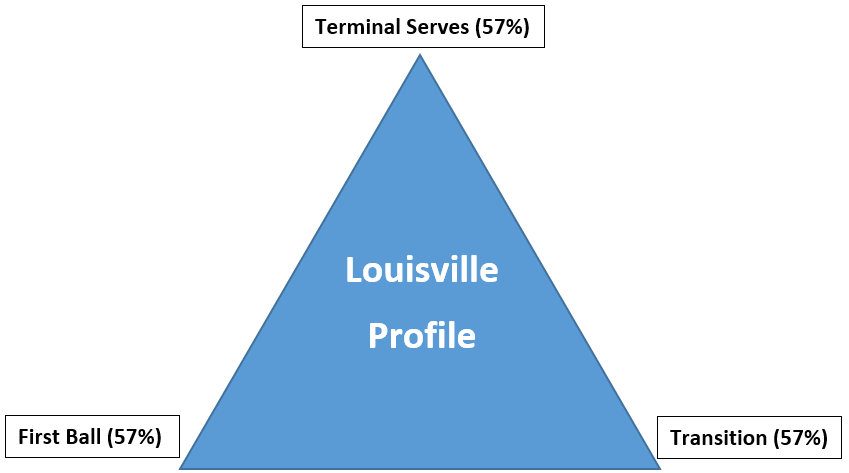Semifinal Preview: Louisville vs Wisconsin
What the Triangle profiles tell us about this matchup...
I’ve spent a lot of time on this blog talking about the Triangle analysis framework. I talked about Terminal Serving and First Ball in more depth, and next weekend I’ll lay out some more information about the Transition element. In these posts I’ve made the case that we want to move from descriptive analysis to prescriptive analysis. From, “what happened?” to “how can we act on that information?”
So, with the NCAA Women’s Final Four tonight, I wanted to run these four teams through the Triangle filter and see if it offers any predictive insight for how these matches will turn out. I try to keep my posts to a 10-minute read or less, so I’m splitting them into two parts.
Hey everybody, I have Louisville’s profile above the paywall, with the rest of this post reserved for premium subscribers. Consider subscribing if you’re enjoying this and want to see more analysis. As a bonus, I’m going to have a subscriber-only Watch Party for the Championship on Saturday. Join me and other Smarter Volley enthusiasts for commentary that goes deeper than, “hitting percentage is sort of like batting average,” (to be fair, it kind of is…) and without needing to be told for the 100th time that the teams play to 25 points and the player wearing the different color jersey is called the libero.
Louisville
As the #1 seed in the tournament, Louisville was always a good bet to make the Final Four. It’s no surprise to see them there. They’ve been dominant throughout the year, with 6 wins1 against eventual Elite 8 teams and an undefeated record. Their overall point differential is the best among the Final Four teams as well. What’s not to like?
Let’s go a little deeper and draw out their Triangle profile:
That’s a pretty balanced profile. And also, a pretty dominant one. 57% is the equivalent of a 25-19 win. You know what, let’s show the Triangle that way:
There wasn’t any area where Louisville wasn’t convincingly better than their opponents.
But, let’s keep things relative and say, relative to being an outstanding team in all aspects (“good teams are good at lots of things”), what stands out as strengths and does anything stand out as a potential weakness?
Louisville won the Terminal Serve battle this season by a greater margin than the other 3 teams in the Final Four. Overall, they won 57% of Terminal Serves. Breaking it down a bit further:
7.0 Ace %
9.2 Error %
3.4 Opponent Ace %
11.6 Opponent Error %
That ace:error ratio is really strong. Nebraska was dominant in serve-pass this year, but not quite as good there. Louisville gets a bit of a boost because their opponents missed a ton of serves against them. If you neutralize opponent errors, Nebraska comes out a little stronger than Louisville in Terminal Serves, but I don’t think that’s necessarily valid. Louisville was a stronger sideout team; maybe teams are a little more aggressive from the service line against them, knowing they are in trouble when Louisville passes well.2
Simply put, there weren’t many teams in NCAA Division 1 volleyball capable of doubling their opponents in a game of Aceball and Louisville was one of them.
It’s not just Terminal Serving either. Louisville opponents passed a mere 41.5% Good Pass. There’s only a moderate correlation between Good Pass % and winning3, but it still matters. What this also leads to is the next stat: Louisville had the best4 opponent hitting efficiency of Final Four teams: both in First Ball and Transition.
So that’s the snowball effect of Louisville. They serve really tough, slow you down in First Ball, and score in Transition. Their First Ball offense is good, but not quite as dominant as Wisconsin or Pitt. We’ll go below the fold to see how Wisconsin profiles and how those two profiles might interact tonight.
Keep reading with a 7-day free trial
Subscribe to Smarter Volley by Joe Trinsey to keep reading this post and get 7 days of free access to the full post archives.




